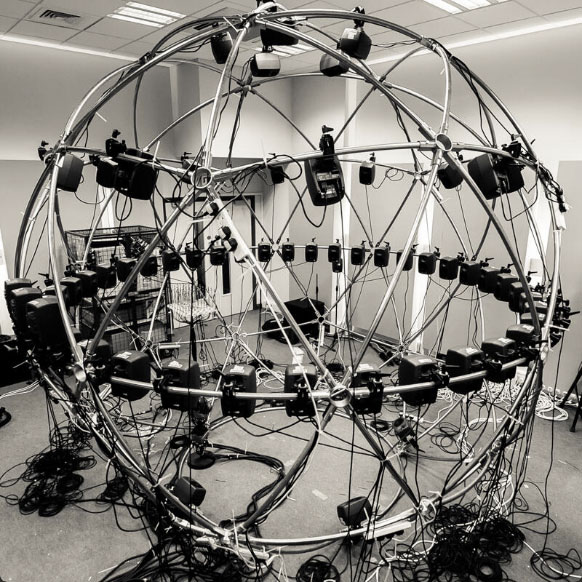Home | Program | Papers | Demonstrations | Venue | Committee | Sponsorship | Registration
Click here to view the demonstrations program. Details of the demonstrations can be found below.
The Surrey Sound Sphere is a geodesic metal structure of radius 1.9m that is used to support 72 Genelec 8020 loudspeakers. These are individually controlled by software via MOTU soundcards. The loudspeaker arrangement is the combination of a regular 60-element circular array mounted on the sphere’s equator and a 22.0 surround format, which includes additional loudspeakers at elevations of approximately −30°, +30° and +90°. The system is installed in the relatively-dead Studio 2 in PATS for sound field control demonstrations of several different methods of forming personal sound zones.

This technology has been developed in collaboration between the University of Southampton and the University of California, San Diego. The real-time DSP engine allows for multi-zone sound reproduction and as multi-channel cross-talk cancellation for binaural audio and for beamforming with listener tracking.
The array was developed at the Institute of Sound and Vibration Research, University of Southampton. This device is designed to generate a highly-directive sound beam for spatially localized audio enhancement. This technology improves the intelligibility of audio material delivered to listeners with reduced hearing capabilities.
In addition to the engineering demonstrations, there will also be an opportunity to participate in perceptual evaluation of interfering sound zones, such as may occur during simultaneous reproduction of television and radio programme material within a single acoustic environment. These will include demonstrations of listening tests / the opportunity to listen to a range of stimuli that are representative of interfering sound zone situations.
This will allow attendees to experience the potential problems that may be perceived within these systems, and how to appreciate how various factors such as programme material choice, system performance, and listener task affect the perceived result.
Yamaha's AFC3 is the 3rd generation of hybrid regenerative acoustic enhancement systems since 1987, using FIR filtering and spatial averaging techniques to achieve system stability with a small amount of independent channels. The 'hybrid' part of the AFC3 system consists of a 4-channel convolution reverberator that is used to adjust the existing acoustic response of the room - rather than replacing it, which is the domain of the 'in-line' systems. The system shown in PATS Studio 1 is a small single module system that enhances the diffuse reverberation field in the audience area as well as on stage, using an AFC3-FIR DSP core with four DPA 4060 omnidirectional microphones, twelve IF2108 loudspeakers, and Dante based audio distribution. The system will be tuned by Takayuki Watanabe of Yamaha's Spatial Audio System Group in Japan, a short presentation will be given by Ron Bakker in the sponsor seminar session on the 3rd. The system will remain switched on throughout the conference for a closer look and listen.


